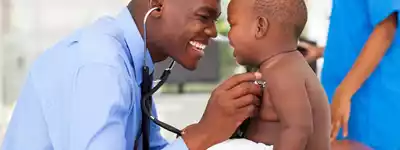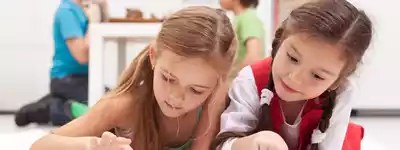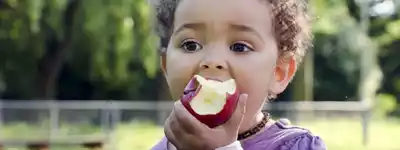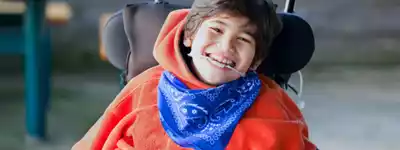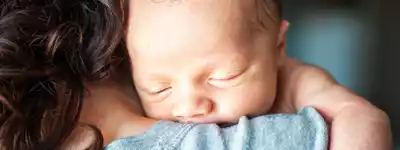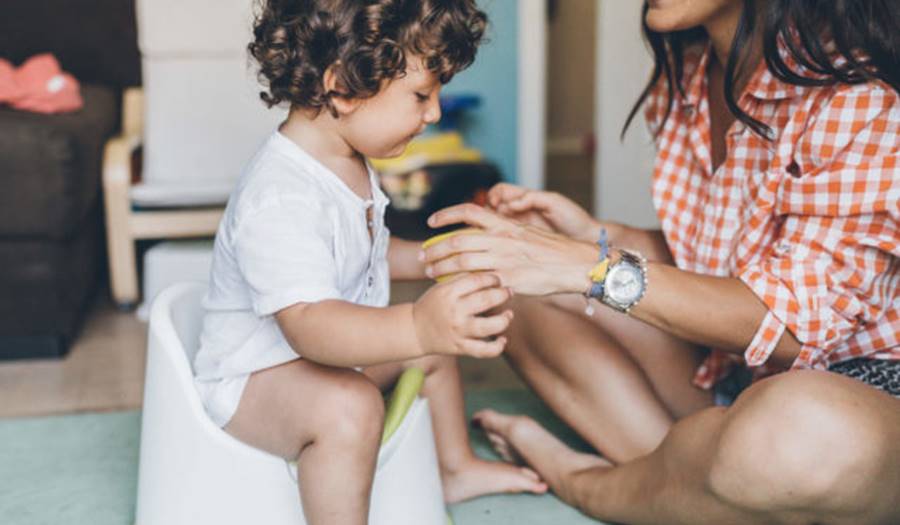
Potty Training
9/6/2021
Parenthood is not all glamour and glitz! It starts off with a lot of diaper changes. But as your child gets older, they become more independent. An independent toddler may be ready for potty training. This is a scary thought for most parents. How do you know if your child is ready? How do you know when to soldier on and when to throw in the towel? How can you help a resistant child? Read on to find out!
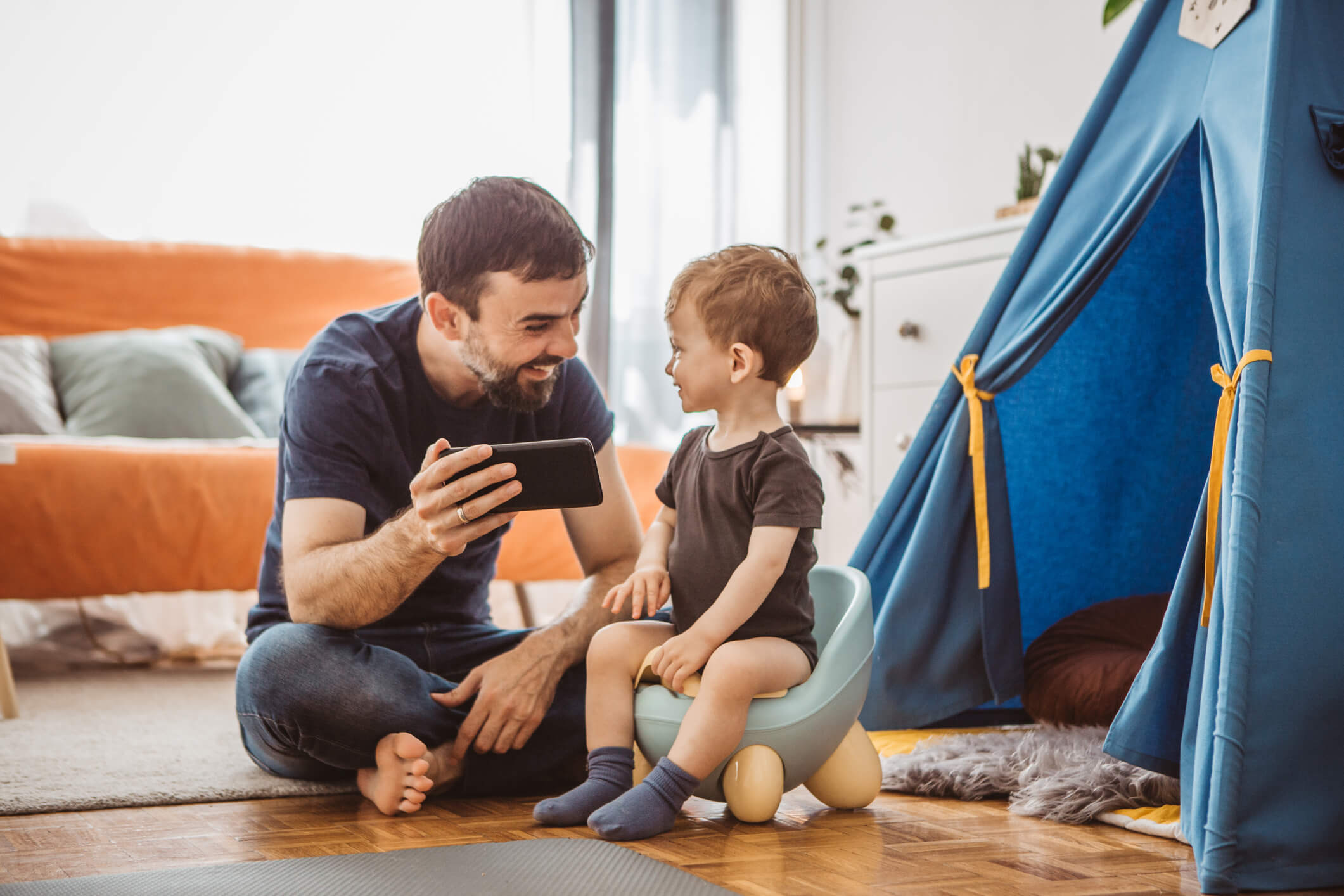
POTTY TRAINING BASICS
When is the right time to start? How can you tell? How to do you start? What should you have at home for equipment? What about pull-ups?
WHEN TO START
Every child is going to start potty training at a different age. Even twins! One twin may be ready, and the other twin may need more time. The average age children start potty training is 22 to 30 months of age. More important than your child’s age is your child’s development. We want
them to be developmentally ready to potty train. Your child is developmentally ready if they
• Want to be more independent
• Have basic communication skills
• Can mostly get themselves dressed or undressed (at least pull up pants and underwear
• Can follow directions
• Can mimic behaviors
• Show these specific toileting-based indicators
• Are aware they have a dirty diaper
• Are curious about using the bathroom
• Need less frequent diaper changes
• Ask for a new diaper when it is wet or soiled
• Start hiding when stooling
It is rare for a child to initiate potty training when they are ready. Instead of waiting for them to say they are ready, you should watch for cues and prepare your child to work on this new skill.
We don’t want to start kids too early but starting too late can come with increased risks. Later training can result in stool refusal (holding stool or refusing to use the bathroom), an overactive bladder, longer duration of night wetting, urinary tract infections, and diaper rashes. A child who starts potty training after 36 months (or just turning 3) has seven times more at risk of developing constipation and 5 times more at risk for prolonged daytime wetting.
GENDER
Gender can play a role when your child starts potty training. Boys on average are later than girls to train. But it is a myth that they are harder to train. Again, every child is different so you should base your potty-training attempts on your child and their signs of readiness.
Boys should learn to use the potty while sitting! It is a safe way to learn. A small toddler will need a stool to stand on in front of a normal toilet. It is easy for a standing child to take a wrong step, or forget they are on a stool, and fall off. Secondly, a child who stands to urinate is much more likely to become constipated. They may feel the urge to stool but because they are standing, they may not respond to that urge. It also is less mess! Urine is caustic and can destroy tiles and wall. A distracted toddler standing to use the potty may move his whole body to turn to a noise or talking. Often at this age, they are unable to stop their urine stream. This results in urine all over the bathroom and a big mess!
DAYTIME VS NIGHTTIME
Some children potty training for both days and night at the same time but frequently, these are two different processes. Daytime training is part physiological changes (holding urine and stool longer) but part behavior (letting urine and stool go at their direction and at a set location). Your child needs to be able to hold their urine, but they also need to participate in the process of letting urine or stool go while on the potty.
Night training is more physiological. The bladder and brain must have a “connection” in which the bladder can wake up the brain when it is full. This may not happen for children who are very deep sleepers. Night training can also take longer in children with a history of constipation. Night wetting may also happen to a previously trained child who is newly constipated, has a urinary tract infection, is stressed, is dehydrated, or who has new onset diabetes.
Nighttime training can be frustrating for some families. Some children will be trained at age 2 and some children will take until they are over 10 years old. Your child is more likely to take longer if there is a family history of prolonged night wetting. If one parent has a history, there is a 25% chance that the child will have prolonged night wetting and that number goes up to 70% there is a history in both parents. Usually, the child will stop night wetting at the same age the affected parent did. Boys are twice as likely as girls to wet the bed at night.
Night wetting is not uncommon. Over 20% of children older than 5, 10% of children over the age of 7, and 5% of children over the age of 10, wet at nighttime. Your child has no control over what happens when they are sleeping and never should be made to feel at fault. Despite this, some children’s self-esteem can suffer. If your child is upset by their bed wetting there are a few things you can do to help:
• Have your child “double void” before bedtime (urinate, do bedtime routine, then urinate right before bed)
• Do a “dream pee “(parents take the child to urinate before they themselves go to bed, often the child is barely awake)
• Wake your child 15 minutes earlier that their normal wake up time (some children are dry but urinate right as they wake up)
• Try to avoid having your child become overtired
• Try a bedwetting alarm-this is the most effective but requires a willing child and take 12 or more weeks to work. This is only for children over the age of 4. It may not work on children who are particularly deep sleepers.
PREPARATION
Children often do better with potty training if we prepare them for the process before starting. Set a start date, usually 3-5 days away, and mark the date on the calendar each day. Watch videos and read books about using the potty. HERE are some suggestions. You can also let your child watch you use the bathroom. Allowing them to watch and to flush can help reduce fear when they start. Role playing can also help. They can use stuffed animal to model the behavior.
Part of your own preparation should be learning or recognizing your child’s potty cues. Your child may have a specific behavior they do before going to the bathroom. These behaviors may include hiding, having a sudden burst of activity, staring off into the distance, or squatting. By learning their cues, you can be ready to intercede and get them to the potty once training starts.
Practice can also prepare them to start potty training. You can have them sit on the potty, fully clothed or naked, to get them used to the seat. You can also practice wiping using dolls or during bath time.
Your child will most likely not wipe by themselves when starting potty training. Their arms are not long enough until about 4 years old. This means they are not able to reach well enough for adequate wiping. Girls may perfect this skill earlier than boys only because they get more practice as they wipe every time they urinate as well as when they stool. Using wet wipes can make wiping easier in the beginning but are not essential. As your child becomes more proficient at wiping you can do “wipe checks” before allowing for full independence.
If your child attends a daycare, let the school know that you have started potty training. Make sure your child has spare clothes at school. It is also important for your child to know that the teacher is there to help them if they need to use the bathroom. Your child should be familiarized with the bathroom set up if they aren’t already.
And lastly, prepare yourself that this is a journey! We are looking for progress and not perfection. Your child will have accidents. They are learning a new skill and it takes time to learn. It is also boring! It’s not fun takes them away from the fun things they are doing. Trust the process and your child!
CLOTHING
Your child should be dressed in a manner that makes potty training easy. Some people prefer having their child just wear underwear around the house or even be naked. Any clothing worn should be loose and easy for your child to pull up and down. Some parents prefer to wait until summer to attempt potty training since it is easier to cut back on layers and easier to spend lots of time outdoors.
Your child can help you pick out their new underwear. There are a ton of fun character underwear sets available and this can increase your child’s excitement. Underwear should be loose when a child is learning. Tight underwear provides a sensory experience that can remind them of a diaper making it harder to remember they have underwear on.
We do NOT recommend pull ups. Pull ups are diapers that can be raised and lowered like underwear. Pull ups seem different from a diaper, but most toddlers see them as a diaper. They wick away urine and do not provide the feedback that an accident does. Pull ups can extend the time it takes for your child to become potty trained. A way you can use pull ups is to put them on OVER underwear when you leave the house. This cuts down on messes from accidents (who wants to clean a car seat cover or the floor at a store?), but the child still has the feedback that they had an accident.
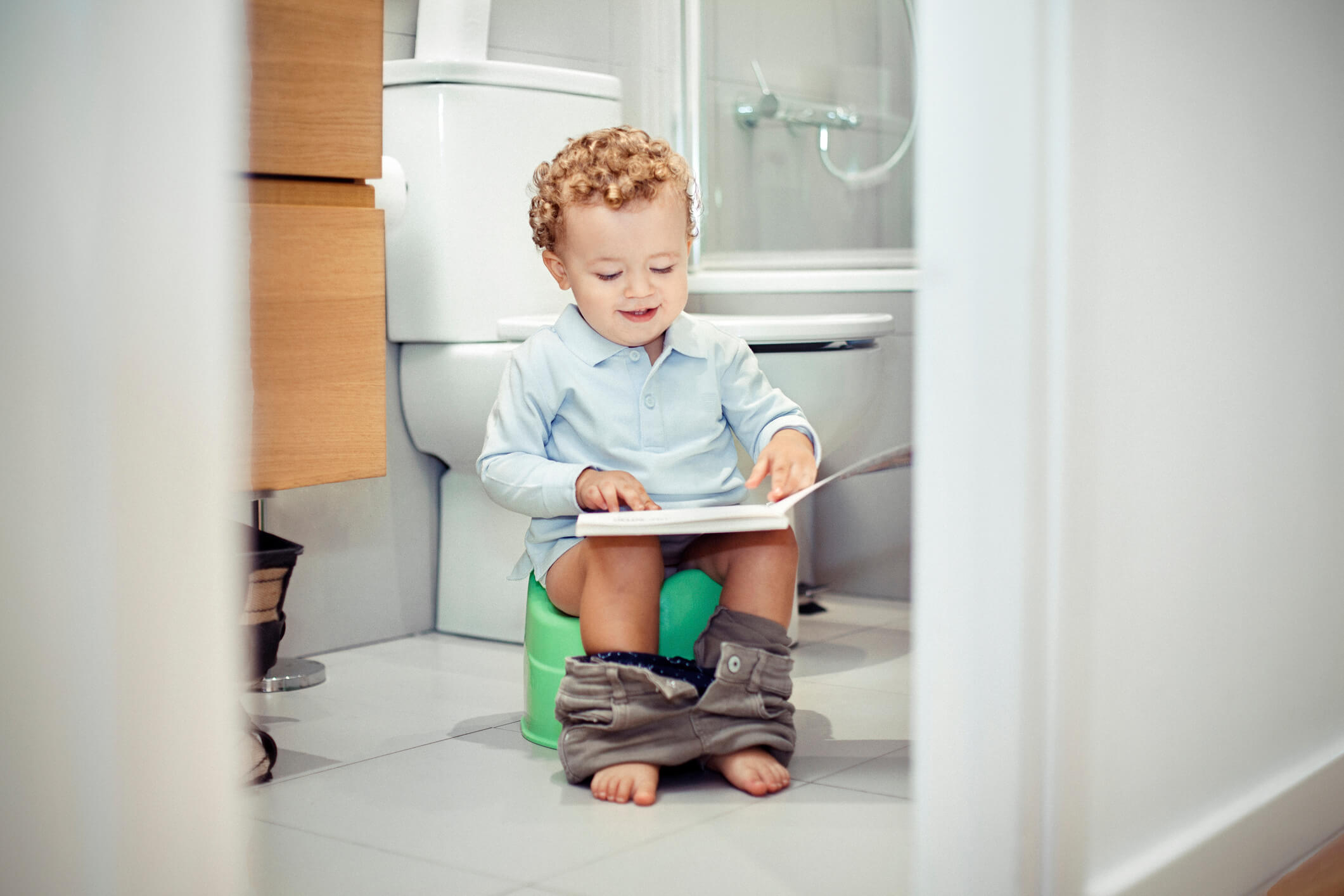
GEAR
Luckily you have most of the potty-training gear you need at home! All you really need is a toilet and toilet paper. Toilets offer the convenience of not needing to transition from a potty to a toilet later. It is also less clean up since there is no potty to clean after. Children who start on the potty will have better exposure for using toilets outside of the home. You may need an child’s potty seat for the toilet to help your child sit more comfortably. A stool is essential for children using a toilet. They need somewhere to rest their feet. Dangling feet make it harder to use the bathroom and increases the risk of constipation.
There are some potty-training products available for convenience and comfort. A toddler potty or a floor potty is one such product. It is small and therefore the correct size for a toddler body. It can be less intimidating to a child just starting out. It also can provide better support and a better physiological position for urinating and stooling. It is easy to move to different rooms or even the car to use when out and about or when traveling.
Also sold for convenience are
• Travel potty seats for public restrooms
• Car seat protectors (you must check with your car seat manual to see what is allowed; some car seat manufacturers make inserts specifically for their seats)
• Potty training waterproof items for beds: peel away sheets, mattress protectors, “pee pads”
HOW TO START
Once the big day arrives, it’s time to start! The timeline for a child to master potty training is variable but it takes most children 2-5 days for it to “click” and 6 weeks for them to master. Generally, by day 3, they have more successes than accidents. At 3 weeks they have accident-free days, need less reminders, and can start to identify the urge on their own. By 6 weeks they are increasingly independent and have rare accidents.
We recommend staying home the first few days and then slowly returning to your routine and leaving the house. When you do leave the house make sure to bring extra outfits, extra shoes or shoes that you can rinse/wipe off, wipes, and a bag to put wet clothing. Also make sure you identify bathrooms for your child at your location so they are aware that they can go and where they can go.
When you initiate potty training, you often need to start with timed toilet training. This means you set a timer and bring your child to the potty when the timer indicates. You can start with 30–45-minute intervals and increase as needed. When the timer goes off, bring your child to the bathroom or potty. Remember not to ask a question unless you are giving a choice! If you ask “do you want to go to the potty” or “do you have to go to the potty” be prepared for most children to say no! No one wants to stop playing to go to the bathroom especially after the fun and newness of the first day wears off. Instead, say “it is time to use the potty” or “I can tell your body is telling you, you need to go potty”. If your child is still hesitant, give them a choice about the potty, its location, the toy they can bring. Giving them some control can help with cooperation.
Some children will urinate frequently, and some are “camels” and only go a few times a day. Both patterns are normal. If your child is comfortable and hydrated do not worry if they don’t urinate frequently. Infrequent urination can be hereditary. If your child does not need to urinate frequently but is pressured to urinate it can result in a negative association with using the potty or they may stop listening to their body’s signals.
When your child is starting out, have them sit for at least 3 minutes to urinate and 5-7 minutes to stool. Make sitting fun if they are reluctant to sit. Bring a book or toy, sing a song, set a fun timer they can turn on and off.
Once your child is getting the hang of things, you can let them practice self-initiating trips to the bathroom. Emphasize that they can use the bathroom when their body tells them they need to go.

REWARDS
Rewards during potty training can be helpful for some children. It can increase motivation or the wiliness to try. A reward is something given to get an effect. It is not a bribe. A reward should be immediate and exclusive. This means it should be an item they receive immediately. It should be exclusive meaning it is a coveted item or an item that is not common to their diet or life. Rewards can be edible, tangible, or non-tangible. Edible rewards can include M&M, mini marshmallows, Hershey kisses, chocolate chips, or other small treats. Tangible rewards can include stickers, small toys or books, party favors, hand stamps, temporary tattoos, or pompoms. Non-tangible rewards can include a painting nails, a trip to see the fire station, baking cookies, choosing a special outfit, staying up 10 minutes later, or picking out the family show or movie. The trick is finding what works for your child! For my youngest, it was a shark squirt gun he was allowed use every time he used the bathroom.
ACCIDENTS
Accidents are messy but expected. Accidents promote learning and reinforce building new skills. Do not shame your child after an accident. It is not helpful to name call, such as calling them dirty, or ask why they did that. Never ever punish a child for having an accident. We don’t punish them if they miss their mouth when trying to self-feed! This is also a learned skill and requires the same latitude for trying and failures.
ON the flip side, we do not want to tell them it is okay to urinate or stool in their underwear. Instead of getting mad or upset, keep all emotion out of it. Helpful things to say include
• Oops you peed (or pooped)
• Remember to only go in the potty, not in your underwear
• Remember we are trying to keep your undies dry
• We can try next time
• You are still learning!
Be prepared for accidents with extra clothing and underwear and wipes. You may also want to cover seats on chairs and couches or roll up throw rugs in the first few weeks of potty training. If you believe your child is ready for night training, having a waterproof mattress cover as well as pull away or waterproof pads on the bed can help for faster middle of the night bed and PJ changes. It is also normal for a child to take longer for night training so you may continue to use diapers during this time.
PELVIC FLOOR MUSCLE ISSUES
Accidents can occur frequently in kids with pelvic floor muscle problems. The pelvic floor muscles are a sling like muscle that holds our organs up in our pelvis. These muscles are strengthened by crawling and balance like activities. These muscles can be affected any child but a child with hypotonia or hypermobility, such as Down syndrome, Cerebral Palsy, Autism, Muscular Dystrophy, Ehlers Danlos syndrome, Spina Bifida, or scoliosis, can be affected.
How can you tell if your child has pelvic floor muscles issues that are causing accidents? If your child has weak pelvic floor muscles, they may frequently leak urine and have no control over these leaks. If their pelvic floor muscles are too strong, they may hold in urine and stool and have a hard time releasing these. Pelvic floor muscles that lack coordination may also result in urination and stooling issues.
These problems are usually long standing and not just a day here and there. If your child has chronic urgency, frequency, leaking or accidents, it may be worth discussing a referral to physical therapy with your primary care provider. Physical therapist can work with your child on their core muscles and pelvic floor muscles to help with weakness, tightness, or lack of coordination.
TROUBLESHOOTING
You started the potty-training process, but things aren’t going well! Here are some solutions to common potty-training problems!
If your child will sit but won’t go, they may need privacy! This is a normal physiological need. You can stand around the corner, hold up a towel or make a “potty tent” to give them privacy. Running water can also help! Turn on the sink or tub faucet and let the water run. You can also put their feet into warm water.The muscles we use to blow bubbles and laugh are the same as the muscles we use to stool and urinate. Make your child giggle, try tickling them or telling a funny joke. Your child can blow soap bubbles or bubbles through a straw to see if activating those muscles helps.
If child’s urine is spraying outside of the toilet when sitting down. If this occurs, make sure they are leaning forward. Boys may need to hold their penis down and girls may even need to apply pressure to their lower pelvic area to make sure urine goes down and not out! Also, make sure their pants are off or down by their ankles so their legs can spread wide. Having pants around the knees hinders the body’s ability to go to the bathroom and makes children lean back, increasing the chance that urine will not end up in the toilet.
POWER STRUGGLES
REFUSAL
If your child refuses to use the potty, give them control back but only the control you want to give. Remember, if you ask a question, you need to be willing to respect the answer. Instead, tell our child it is time to go to the potty and then give them a choice. Let them choose underwear, when to go, or where to go.
Also try limiting the pressure you are putting on them. If you are asking them to go too frequently, try stretching out the time from 30-45 minutes to 1-1.5 hours, longer if they are successful with that interval. Too much pressure can cause resistance.
If your child is holding all day until you put a diaper on at bedtime, it may be worth stopping all diapers. You may also need to change their stooling schedule with dietary changes (see below) and a stooling routine to make sure they are stooling before bedtime.
If your child refuses to stool on the potty, you are not alone. This is one of the most common potty-training issues we see based on change of routine and fears. A child very rarely feels wet or urine with the technology in diapers. But they do feel stool. This feeling doesn’t not happen when they use a toilet or potty. This change in sensation can be scary for some children.
A child that refuses to stool on the potty may hold their stool resulting in constipation. If they are constipated, it may hurt when they stool. If they have a painful bowel movement on the potty (or even their diaper) they associate stooling with pain and continue to hold their stool. Their faulty logic, that if they don’t poop it can’t hurt, starts a vicious cycle that can be hard to reverse. To get your child to stool on the potty:
• Make sure they are in the correct position for stooling: knees above hips and feet flat and supported. They should be leaning forward. This may mean getting a properly sized stool or using a small potty so they can have their feet on the ground
• Make sure they are sitting long enough (5-10 minutes)
• Bring a distraction or toy to make sure they sit long enough
• Utilize the body’s natural rhythms: have your child sit 20 minutes after a meal, this is the time your body is most likely to go
• Give your child privacy
• Change their diet or add foods that promote stooling
o Foods such as raspberries, pears, apples, plums, peas, broccoli and corn help stooling
o Foods such as avocado, nut butters, and full fat yogurt promote stooling
o Magnesium is also essential for stooling. A child needs 80mg until age 4. After age 4, they need 130mg. Almonds, seeds, popcorn, dark chocolate, kale, cereals, and flaxseeds are high in magnesium.
o You can make “Potty smoothies” or “Potty Popsicles” from a combination of fat, fiber, and natural probiotics that can help stooling (recipe courtesy of @thepottytrainingconsultant)
• Blend ½ can full fat coconut milk, 2 TBSP full fat plain yogurt, a handful of froze pineapple and strawberry chunks, a handful of shredded coconut
• Treat any constipation immediately. This may require a dietary change or even a laxative. If you are looking for a dietary change you can try the “constipation smoothie” as recommend by the @thepottytrainingconsultant
o Blend together ½ cup apple juice, 1 and 1/2 cups of frozen berries, 4 prunes, ½ cup Greek yogurt, 1 TBSP chia seeds, 1 TBSP coconut oil, 1 tsp hemp seeds or flax, and ½ tsp cinnamon
o If dietary changes to do make a difference they may need medication such as MiraLAX, Ex-lax, or added fiber supplements. Please see our constipation blog from January 2021 for more advice.
• If your child is showing signs they may need to stool, take off their underwear and let them run around bare bottom to encourage them to use the potty.
• Use books or apps to help alleviate fears and normalize pooping on the potty. See the side bar for book suggestions. An app that may be helpful is ‘The Poop Goes to Poopland”.
• Don’t talk about poop or stooling in a negative manner
• Empty any poop in diapers into the toilet (this helps if started before potty training)
REGRESSIONS
Regressions can occur if your potty-trained child starts having frequent accidents. Regressions, or a return to previous behaviors, can happen for several reasons. These include medical issues, stress, a new baby in the family, family changes. Regressions can signal your child needs extra comfort or attention. If you fear it may be a medical problem, make sure to have that ruled out before proceeding. Otherwise, during regressions remain consistent, offer extra attention and support but do not return to diapers.
INTENTIONAL SOILING OR ACCIDENTS
This can be SO frustrating. Your child understands the process, has learned the skill, and may have a period of being fully potty-trained. Often your child will tell you they need to go, then look right at you and urinate or stool. Or they may sit on the potty against their will and then get up and urinate or stool. The difference between these and regressions is the defiant behavior associated with the urinating and stooling.
First, see if there is a known trigger. If these intentional accidents are due to stress, follow the steps discussed above for regressions. If there is no known trigger for this behavior, we need to start with behavioral management. If you are using rewards, you may need to take a break from the reward process. If you stopped rewards a long time ago, it may help to bring them back. Go back to the basics and the beginning steps of potty training. You can start with timed toilet training and slowly increasing self-initiation over time. The good news is because they have learned, this process should be much faster.
And leave all emotions out of the process! Remember our 3-week behavior series? Children love attention and reactions. Do not give an elevated reaction or increased attention to the accidents as these may increase the undesired behaviors. Praise and acknowledge the desired behavior.
TOILET TANTRUMS
Toilet tantrums are severe behavioral reactions to toilet training. If your child has a temper tantrum when you bring them to the potty or suggest using it, it requires behavioral intervention. If they struggle with transitions between activities, they may need more warning. Set a short timer, from 1-5 minutes, after telling them it will be time to use the potty. It is important to also important to not ask “if” they need to go even if you see they need to go. If you ask and they say no, and you insist, this can increase the chance of a meltdown. This is because you asked a question that gives them a sense of control, when you don’t respect their answer, they react to that control being taken away. Remember to only give choice when acceptable. And give control or choices where it is appropriate.
If your child is in the middle of the meltdown, do not try to force the on the potty or reason with your child. Wait until the big feelings have passed to talk to them about the potty or guide them to the potty. If you need more help working on big emotions with your child, please see our 3-week behavior series from May 2021.
AUTISM
Autistic children need special considerations around potty-training. They do not necessary take longer or start at an older age, but the process may be different. Depending on their verbal abilities, you may need to increase the use of visual supports. You also need to be mindful of the potentially unpleasant or disturbing sensory input that comes along with potty training. Toilets can be noisy, the seats may be cold, hard, or uncomfortable. Odors in the bathroom can bother some autistic children. The positions required for sitting on the potty may also be problematic for some autistic children. Autistic children are also more likely to be constipated due to diet as well as pelvic floor muscles issues. Before you start potty training, discuss any concerns with your child’s primary care provider.
WHEN TO STOP
We recommend continuing with toilet training if you feel your child is ready even if they are having frequent accidents. But when should you throw in the towel or take a break? If your child is starting potty training and has a new illness, injury, or medical issue, it is worth it to take a break or pause training. If your child has made no progress after 5 days of diligent training, it may be time to take a step back and try again later. Lastly, if your mental health or your child’s mental health is at risk because of the potty-training process, take a break and try again later! It is not worth the potential problems that situation may result in.
Potty training is a parenting rite of passage. It is often a scary milestone to reach but with the right preparation, gear, and knowledge, the process can be smooth and easy. If you have questions about potty-training or are struggling with potty-training, please do not hesitate to discuss with your primary care provider.
Children’s Health Care of Newburyport, Massachusetts, and Haverhill, Massachusetts is a pediatric healthcare practice providing care for families across the North Shore, Merrimack Valley, southern New Hampshire, and the Seacoast regions. The Children’s Health Care team includes pediatricians and pediatric nurse practitioners who provide comprehensive pediatric health care for children, including newborns, toddlers, school-aged children, adolescents, and young adults. Our child-centered and family-focused approach covers preventative and urgent care, immunizations, and specialist referrals. Our services include an on-site pediatric nutritionist, special needs care coordinator, and social workers. We also have walk-in appointments available at all of our locations for acute sick visits. Please visit chcmass.com where you will find information about our pediatric doctors, nurse practitioners, as well as our hours and services.
Disclaimer: this health information is for educational purposes only. You, the reader, assume full responsibility for how you choose to use it.


